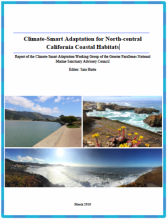Climate-Smart Adaptation for North-central California Coastal Habitats

The North-central California coast and ocean is a globally significant and extraordinarily productive marine and coastal ecosystem that boasts an array of local, state and federal protected areas and other managed lands. Despite this richness and attention to conservation, this region is still vulnerable to the effects of climate change. The Greater Farallones National Marine Sanctuary Advisory Council (Council) convened the multi-agency Climate-Smart Adaptation Working Group (Working Group) in response to the need to develop climate-smart adaptation strategies to enable coastal and marine resource managers to respond to, plan, and manage for the impacts of climate change. Working Group members sought to provide strategies to help ensure long-term viability of the species and habitats natural resource agencies are mandated to protect, and the public values. Building on Phase 1 of the Greater Farallones National Marine Sanctuary’s Climate-Smart Adaptation Project that assessed vulnerability to climate and non-climate stressors for select species, habitats, and ecosystem services, the Working Group undertook a yearlong multi-agency process to develop the climate-smart adaptation strategies presented in this report. The strategies were presented to the Council for discussion, modification, and approval, and forwarded to the Sanctuary Superintendent for consideration in current or future adaptation planning efforts.
The Council Working Group developed 50 priority strategies and 28 lower priority strategies in 10 categories, including Alleviate Climate Impacts, Manage Dynamic Conditions, Promote Education, Protect and Restore Habitat, Limit Human Disturbance, Address Invasive Species, Promote Landward Migration, Invest in Science Needs, Protect Species, and Manage Water Quality. Strategies were also characterized in terms of timeframe, location, strategic management action, stressor addressed, key partners and required resources.
While there is much work on tropical marine adaptation action, temperate regions to date have had many fewer resources. The Council Working Group’s contribution aims to turn this tide and begin a wave of implementation of climate-smart temperate coastal and marine management.
Hutto, S.V., editor. 2016. Climate-Smart Adaptation for North-central California Coastal Habitats. Report of the Climate-Smart Adaptation Working Group of the Greater Farallones National Marine Sanctuary Advisory Council. San Francisco, CA. 47 pp.
